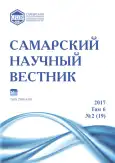Dynamics of ticks’ infection with a tick-borne encephalitis virus in some areas of Kirov Region
- Authors: Bessolitsyna E.A.1, Nozdrina E.V.1, Volkov S.A.1
-
Affiliations:
- Vyatka State University
- Issue: Vol 6, No 2 (2017)
- Pages: 14-18
- Section: 03.02.00 – General Biology
- URL: https://journals.rcsi.science/2309-4370/article/view/21788
- DOI: https://doi.org/10.17816/snv201762102
- ID: 21788
Cite item
Full Text
Abstract
In this research we studied the dynamics of infestation of ticks with European and Siberian isoforms of tick of tick-borne encephalitis virus collected from 2007 to 2016 from vegetation cover, domestic animals and clothes in Kirov, Kirovo-Chepetsk, Orychevsky, Zuevsky, Slobodsky and Turinsky districts of Kirov Oblast. All collected samples were analyzed for the presence of tick-borne encephalitis virus in them. The virus isoforms were detected by reverse transcription - polymerase chain reaction (RT-PCR). The analysis revealed the dynamics of the percentage of ticks infected with isoforms of tick-borne encephalitis virus. In the central regions, which share common borders, it was revealed the coincidence of the peaks of infection with the European isoform virus, but further studies are needed to determine the periodicity. It was also noted that for some areas, the maximum peak of infection and the increase in the time between peaks are characteristic. A low percentage of contamination in the territory of Kirov city could be associated with treatment with acaricides. Since 2011, in the Kirov region, there have been cases of ticks infected with tick-borne encephalitis virus from the Siberian isoform. Every year there is an intensive penetration of the Siberian isoform westward through the territory of the Kirov Region. Periodicity of peaks is approximately 3 years.
Full Text
##article.viewOnOriginalSite##About the authors
Ekaterina Andreevna Bessolitsyna
Vyatka State University
Author for correspondence.
Email: bess2000@mail.ru
candidate of biological sciences, associate professor of Microbiology Department
Russian FederationElena Vasil’evna Nozdrina
Vyatka State University
Email: lena_nozdrina@mail.ru
student of Institute of Biology and Biotechnology
Russian FederationStanislav Alexandrovich Volkov
Vyatka State University
Email: volkov210691@mail.ru
postgraduate student of Microbiology Department
Russian FederationReferences
- Lindquist L., Vapalahti O. Tick-borne encephalitis // Lancet. 2008. V. 371, №5. P. 1861-1871.
- Казанцев А.П., Матковский В.С. Справочник по инфекционным болезням. М.: Медицина, 1985. 184 с.
- Токаревич К.Н. Важнейшие инфекционные болезни, общие для животных и человека. Л.: Медицина, 1979. 221 с.
- Randolph S.E. Tick ecology: processes and patterns behind the epidemiological risk posed by ixodid ticks as vectors // Parasitology. 2004. V. 129 Suppl. P. 37-65.
- Столбова Ф.С., Бердинских И.С. Осенняя активность клещей рода Dermacentor Koch. на юго-западе Кировской области // Проблемы биомониторинга и биоиндикации: сб. мат-лов VIII всерос. науч.-практ. конф. Киров; 2010. Ч. 2. С. 17-21.
- Biernat В., Karbowiak G., Werszko J., Stanzak J. Prevalence of tick-borne encephalitis virus (TBEV) RNA in Dermacentor reticulatus ticks from natural and urban environment, Poland // Exp Appl Acarol. 2014. V. 64. P. 543-551.
- Tonteri E., Jääskeläinen A.E., Tikkakoski T., Voutilainen L., Niemimaa J., Henttonen H., Vaheri A., Vapalahti O. Tick-borne encephalitis virus in wild rodents in winter, Finland, 2008-2009 // Emerg Infect Dis. 2011. V. 17. P. 72-75.
- Юрченко О.А., Виноград Н.А., Дубина Д.А. Молекулярно-генетическая характеристика вируса клещевого энцефалита в Крыму // Вопросы вирусологии. 2012. Т. 57, № 3. C. 40-44.
- Иерусалимский А.П. Клещевой энцефалит. Руководство для врачей. Новосибирск, 2001. 359 с.
- Филиппова Н.А. Таежный клещ Ixodes persulcatus Schulze (Acrania, Ixodidae): морфология, систематика, экология, медицинское значение. Л.: Наука, 1985, Т. 1, 352 с.
- Sambrook J., Fritch T., Maniatis T. Molecular cloning: a laboratory manual. NY: Cold Spring Harbor Laboratory Press, 1989.
- Ruzek D., St`astna H., Kopecky J., Golovljova I., Grubhoffer L. Rapid subtyping of tick-borne encephalitis virus isolates using multiplex RT-PCR // J. Virol. Met. 2007. Vol. 144. P. 133-137.
- Пышкин В.Б., Евстафьев И.Л., Евстафьев А.И. К экологии и биоразнообразию рода Dermacentor Koch., иксодиофауны Крыма (Acrania, Ixodidae) // Экосистемы Крыма, их оптимизация и охрана. 2006. С. 30-35.
- Sahai H., Anwer Khurshid H. On analysis of epidemiological data involving A 2X2 contingency table: an overview of fisher’s exact test and yates’ correction for continuity // Journal Biopharm. Stat. 1995. V. 1, №1. P. 43-70.
- Бессолицына Е.А., Волков С.А., Столбова Ф.С., Дармов И.В. Анализ зараженности клещей вирусом клещевого энцефалита на территории Кировской области // Инфекция и иммунитет. 2014. Т. 4, № 3. С. 275-278.
- Управление федеральной службы по надзору в сфере защиты прав потребителей и благополучия человека по Кировской области [Электронный ресурс] // http://43.rospotrebnadzor.ru.
Supplementary files








